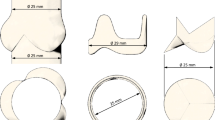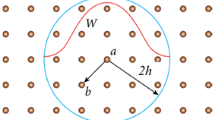Abstract
Understanding the hemodynamics surrounding the venous valve environment is of a great importance for prosthetic valves design. The present study aims to evaluate the effect of leaflets’ stiffening process on the venous valve hemodynamics, valve’s failure on the next proximal valve hemodynamics and valve’s failure in a secondary daughter vein on the healthy valve hemodynamics in the main vein when both of these valves are distal to a venous junction. Fully coupled, two-way fluid–structure interaction computational models were developed and employed. The sinus pocket region experiences the lowest fluid shear stress, and the base region of the sinus side of the leaflet experiences the highest tissue stress. The leaflets’ stiffening increases the tissue stress the valve is experiencing in a very low fluid shear region. A similar effect occurs with the proximal healthy valve as a consequence of the distal valve’s failure and with the mother vein valve as a consequence of daughter vein valve’s failure. Understanding the described mechanisms may be helpful for elucidating the venous valve stiffness–function relationship in nature, the reasons for a retrograde development of reflux and the relationship between venous valves located near venous junctions, and for designing better prosthetic valves and for improving their positioning.








Similar content being viewed by others
References
Buescher C, Nachiappan B, Brumbaugh J, Hoo K, Janssen H (2005) Experimental studies of the effects of abnormal venous valves on fluid flow. Biotechnol Prog 21:938–945
Buxton GA, Clarke N (2006) Computational phlebology: the simulation of a vein valve. J Biol Phys 32:507–521
Chen HY, Berwick Z, Krieger J, Chambers S, Lurie F, Kassab GS (2014) Biomechanical comparison between mono-, bi-, and tricuspid valve architectures. J Vasc Surg Venous Lymphat Disord 2(188–193):e181
Cutnell J, Johnson K (1998) Physics, 4th edn. Wiley, New York
Eberhardt RT, Raffetto JD (2005) Chronic venous insufficiency. Circulation 111:2398–2409
Formaggia L, Veneziani A (2003) Reduced and multiscale models for the human cardiovascular system. Lecture Notes VKI Lecture Series 7
Huang H-YS, Liao J, Sacks MS (2007) In-situ deformation of the aortic valve interstitial cell nucleus under diastolic loading. J Biomech Eng 129:880–889
Labropoulos N, Giannoukas AD, Delis K, Mansour MA, Kang SS, Nicolaides AN, Lumley J, Baker WH (1997) Where does venous reflux start? J Vasc Surg 26:736–742
Lurie F, Kistner R (2012) The relative position of paired valves at venous junctions suggests their role in modulating three-dimensional flow pattern in veins. Eur J Vasc Endovasc Surg 44:337–340
Lurie F, Kistner RL, Eklof B, Kessler D (2003) Mechanism of venous valve closure and role of the valve in circulation: a new concept. J Vasc Surg 38:955–961
Marom G (2015) Numerical methods for fluid–structure interaction models of aortic valves. Arch Comput Methods Eng 22:595–620
Marom G, Haj-Ali R, Raanani E, Schäfers H-J, Rosenfeld M (2012) A fluid–structure interaction model of the aortic valve with coaptation and compliant aortic root. Med Biol Eng Comput 50:173–182
Meissner MH, Moneta G, Burnand K, Gloviczki P, Lohr JM, Lurie F, Mattos MA, McLafferty RB, Mozes G, Rutherford RB (2007) The hemodynamics and diagnosis of venous disease. J Vasc Surg 46:S4–S24
Spivack DE, Kelly P, Gaughan JP, van Bemmelen PS (2012) Mapping of superficial extremity veins: normal diameters and trends in a vascular patient-population. Ultrasound Med Biol 38:190–194
Thiriet M (2015) Physiology and Pathophysiology of Venous Flow. PanVasc Med. 569–589. doi:10.1007/978-3-642-37078-6_27
Tien W-H, Chen H, Berwick Z, Krieger J, Chambers S, Dabiri D, Kassab G (2014) Role of sinus in prosthetic venous valve. Eur J Vasc Endovasc Surg 48:98–104
Zervides C (2010) 3D modelling of a venous valve: how effective are postural changes under gravity, in ‘washout’ recirculatory regions in the lee of venous valves? Pliroforiki:38–44
Zervides C, Giannoukas A (2013) Computational phlebology: reviewing computer models of the venous system. Phlebology 28:209–218
Author information
Authors and Affiliations
Corresponding author
Rights and permissions
About this article
Cite this article
Soifer, E., Weiss, D., Marom, G. et al. The effect of pathologic venous valve on neighboring valves: fluid–structure interactions modeling. Med Biol Eng Comput 55, 991–999 (2017). https://doi.org/10.1007/s11517-016-1575-9
Received:
Accepted:
Published:
Issue Date:
DOI: https://doi.org/10.1007/s11517-016-1575-9




